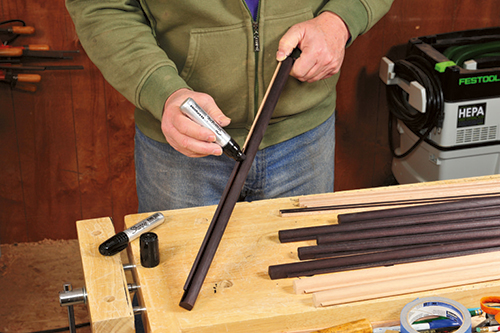
What are some methods for ebonizing wood?
Ellis Walentine: Over the years, I’ve heard of a lot of different formulas for ‘ebonizing’ wood. The old-fashioned way is to soak a piece of rusted steel wool or some rusty nails in vinegar for a few days, then strain the resulting black liquid and use it as a dye stain. My few attempts with this method resulted in a color something less than black.
I’ve gotten the best results with Constantine’s black NGR (non-grain-raising) stain. I tried other brands of dye stain, but the Constantine’s product has a cooler, more neutral black color that’s more like genuine ebony. I apply at least two or three coats to assure good penetration and thorough coloring. Use rubber gloves when staining, because the solvents in the NGR stain will dry out your hands mercilessly ? not to mention blacken them beyond recognition. Be sure to wait a day or two for the stain to dry completely before applying a lacquer finish over it or you will have problems with the finish drying properly.
Michael Dresdner: There are many, including some convoluted ones like iron buff (a liquid extracted by filtering the results of rusted metal soaked in vinegar) which work primarily on high tannin woods, and the usual run of dyes. None of these work particularly well. By far the best and easiest is India ink. Unlike dyes, which tend to show too much wood and end up looking either blue/black or green/black, India ink, a pigment, is true black. It comes in oil or waterbased versions (I prefer the waterbased) and will generally go full black in just one application. However, because it is a pigment, you can let it dry and reapply for deeper black.
For more depth and a truly classic look, stain the wood first with India ink, then add a small amount of black dye into each clear coat of finish that you apply.





